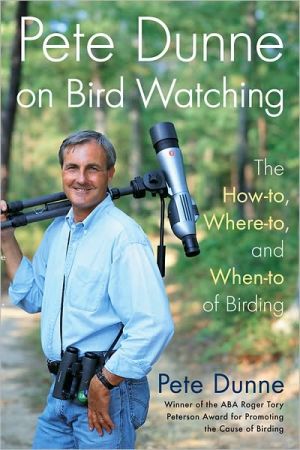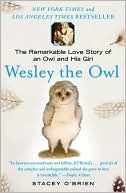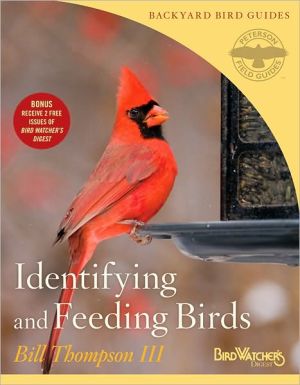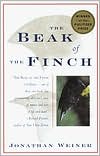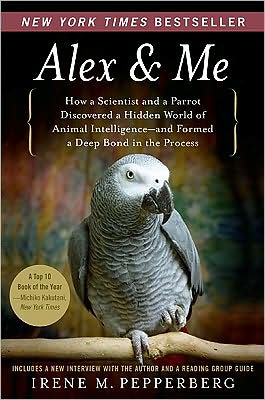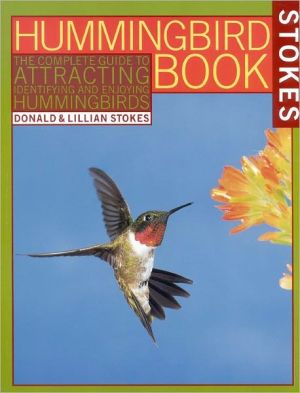Pete Dunne on Bird Watching: The How-to, Where-to, and When-to of Birding
Pete Dunne has taught birding to beginners for years, but he has never found the right book to help them get started. Now the popular birding author identifies the skills and tools available to people with any amount of interest, great or small, in bird watching. Beginning with backyard birding and moving through a quick but comprehensive survey of tools of the trade, Dunne outlines ten basic, simple steps in bird identification that can make a birder out of the most casual of...
Search in google:
Pete Dunne has taught birding to beginners for years, but he has never found the right book to help them get started. Now the popular birding author identifies the skills and tools available to people with any amount of interest, great or small, in bird watching. Beginning with backyard birding and moving through a quick but comprehensive survey of tools of the trade, Dunne outlines ten basic, simple steps in bird identification that can make a birder out of the most casual of observers. He goes on to show beginning birders how to use their skills to explore new horizons through birding by ear, birding by telescope, and finding and identifying rare or difficult birds. Written in the lively, authoritative style that has made Dunne one of the most popular writers in this field today, Pete Dunne on Bird Watching will inspire in readers both a growing passion for birding and a lifelong respect for the natural world and its inhabitants. Publishers Weekly Judging by the great number of field guides in print, bird watching is among the world's most popular avocations. Dunne (Hawks in Flight) takes a new tack, providing novice birders and those thinking of taking up the hobby with a literate and exhaustive beginner's manual. The quirky and often poignant anecdotes sprinkled throughout the book also make for an interesting read for advanced birders. From the backyard to field trips and guided tours, the author provides valuable information that would take years of in-the-field effort to obtain. Dunne's advice on binocular design, specifications and uses is easy to understand, despite the technical data. There are also helpful suggestions on proper clothing and footwear, which take into account terrain, season and climate. The author explains such esoterica as why birders should never wear white as well as the finer points of proper bird-watching etiquette. There is an important section discussing a range of field guides and how to use them based on the essential keys to bird identification found in these compendiums. Additionally, this birding primer details the best sites for viewing particular species; where to find more information on bird watching; and how to move beyond the initial level of this fascinating pastime into the more sublime reaches of advanced birding. 100 b&w photos. (Mar.) Copyright 2003 Cahners Business Information.
Introduction\ Every Monday, 7:30 A.M., South Cape May The parking lot had ten cars in it—about average for a Monday in early July. Come September, when bird migration runs full bore and birders are packing Cape May motels, the lot is full.\ I parked in a spot that promised shade. Reached for the binoculars that live under the driver’s seat. Extracted myself from the car, exhumed my spotting scope from the trunk, then paused, filtering the world through senses refined by more than forty years of birding.\ The silhouette on the utility line belonged to the local mockingbird. My ears told me he was running through his standard repertoire (which even by mockingbird standards was considerable).\ Audio reconnaissance also detected the spiraling yodel of a descending yellowlegs, a migrating shorebird, and the silver-toned call notes of Bobolinks migrating high overhead.\ All the signs suggested a good day’s birding, maybe even a great day’s birding. Every morning I wake up carries this potential.\ “Good morning,” I said to the semicircle of faces. “I’m director of New Jersey Audubon Society’s Cape May Bird Observatory. You have very cleverly positioned yourself at the crossroads of migration at the junction of three seasons.” I paused, allowing time for this disclosure to sink in. When most people think of bird migration, they focus upon the peak congestion periods in the spring and fall. The fact is that over much of North America birds are shifting constantly—from north to south, south to north, interior to coast, higher elevation to lower; from places with exhausted resources to places offering birds greater opportunity.\ What this means for people who watch birds is that every trip afield is a treasure hunt with endless possibilities. Making the most of these opportunities is a matter of getting the right equipment, putting yourself in fortune’s path, and learning how and where to look.\ Topics which are, not coincidentally, central to this book.\ Assisting me on my morning walk were two of Cape May Bird Observatory’s associate naturalists. Tom Parsons, a retired professor of vertebrate biology, has been a birder all his life. Bill Glaser, a former engraver, took up birding after retirement. Together they make a wonderfully balanced team and a good point: shared interest, not experience, is the common denominator in birding. It truly doesn’t matter if you started birding yesterday, last year, or before field guides were invented. All birders, no matter what their skill level, are drawn to the same thing: the excitement, the challenge, and the pleasure that comes from watching birds. And all birders are eager to share their knowledge with others, an ethic that is fundamental to field trips and, as you will discover, this book.\ I resumed my litany, explaining to regulars and newcomers alike what we were about to do, how long we would be about it, and what special birds of the season we were likely to encounter. As I spoke, I tried to gauge the skill levels of my listeners, to discern who might need extra attention or guidance. It seemed a pretty eclectic group.\ Several individuals armed with high-quality, well-used binoculars were evidently serious birders who knew Cape May’s fame and had probably come with a shopping list of species they hoped to see.\ Most of the members of the group, however, looked more casually interested in birds. Several were carrying bird guides that might have been useful for back-yard bird watching but whose deficiencies made them more hindrance than help in the field. Even people who are casual about birding shouldn’t be frustrated by it. I made a mental note to engage them during the walk and recommend a more field-worthy guide.\ Far too many individuals were armed with binoculars that wouldn’t pass muster—gimmick-ridden instruments that were too large, too small, or too poorly designed to be useful in the birding arena. We’d replace these with instruments from our arsenal of well-chosen loaners.\ There were also a number of people, including a family of four, who were clearly beginners. The birds, the names, the skills, the etiquette, the very process of seeing a bird critically, noting distinguishing characteristics, and finding its likeness in a book, would be new to them.\ This process, which binds a bird with its name, is replicated in this book. While the information in this book is intended to serve birders of all interests and skill levels, it has been organized to follow the developmental stages that birders go through as their interest develops and their horizons expand.\ Must you read this book just to go out and look at birds? No. You can do what I did at the age of seven. Grab binoculars. Run out the bacck door. Start peering into the trees.\ But you will discover (if you have not already) that there is a vast difference between looking for birds and finding them. While looking is fun, finding is more fun. And being able to identify what you find is the most fun of all. If forty years ago I had had this book, I would have found a good many more birds, been frustrated a good deal less, and been a better birder for it today.\ I also would have devoured this book. Because it answers many of the questions I faced in my early efforts to become a better field birder—the same questions birders face today.\ “Any questions?” I asked the group.\ There were none, yet, but over the course of the next two hours there would be many.\ The mockingbird (who had never stopping singing) offered a more than passable rendition of a flicker’s call . . . then Killdeer . . . then a Carolina Wren. . . . Out of a cotton and cobalt sky the piped whistle of a high- flying Osprey drifted to earth, and beyond the dunes a string of Brown Pelicans lofted into momentary view, then disappeared.\ It sure was shaping up to be a good day. Maybe even a great one.\ “Okay,” I said, “let’s go birding.”—September 2002\ Copyright © 2003 by Pete Dunne. Reprinted by permission of Houghton Mifflin Company.
Introductionxiii1.Back-yard Birding, Front-seat Adventure1Stefancik's Corollary1America's Fastest-Growing Outdoor Activity3Setting the Table for Birds4Landscaping for Birds22Bird-feeding Problems27Attracting Birds with Water32Nest Boxes34The Other Side of the Fence392.The Tools of the Trade--Binoculars and a Field Guide41Of Chimney Swifts and Larceny41Binoculars--The Defining Tool of Birding44Field Guides--The Rosetta Stone to Birds68Clothing85Other Things You'll Need893.The Fundamentals of Birding91Like Grosbeaks for Purple Finch91Where, When, and How to Go Birding93Basic Bird Identification100Learning to See Critically112Keeping Records1154.Resources--Dipping into the Pool of Knowledge121The Man of the Mountain121Clubs and Chums--The Social Link125Hooking into the Publication and Communication Network132Birding Tours136Events, Functions, Festivals, and Other Birders1395.Expanding Horizons--Finding and Facing New Challenges141That Story About the Harrier141Sight--Spotting Scopes and Tripods145Sound--Birding by Ear154Travel to New Birding Locations164Mastering Difficult Identifications1826.Applied Birding--For Fun, Purpose ... Even Profit!189October 4, 1977, Cape May Point, New Jersey189Bird Censusing191The Games Birders Play1997.Tips to Better Birding206At Birding's Horizon Line--Standing with Will206Equipment Tips207Technique Tips2148.Ethics and Responsibilities233Looking for Baird's Sparrow, Walking on Eggs233Keeping Birding Safe for Birds234The Etiquette of Birding237Courtesy to Nonbirders241Conservation242Appendixes1.American Birding Association Checklist2512.Name Changes to the American Ornithologists' Union (and ABA) Check-list2783.State Audubon Societies and Bird Observatories2894.American Birding Association Code of Birding Ethics293Glossary296Bibliography309Index312
\ Publishers WeeklyJudging by the great number of field guides in print, bird watching is among the world's most popular avocations. Dunne (Hawks in Flight) takes a new tack, providing novice birders and those thinking of taking up the hobby with a literate and exhaustive beginner's manual. The quirky and often poignant anecdotes sprinkled throughout the book also make for an interesting read for advanced birders. From the backyard to field trips and guided tours, the author provides valuable information that would take years of in-the-field effort to obtain. Dunne's advice on binocular design, specifications and uses is easy to understand, despite the technical data. There are also helpful suggestions on proper clothing and footwear, which take into account terrain, season and climate. The author explains such esoterica as why birders should never wear white as well as the finer points of proper bird-watching etiquette. There is an important section discussing a range of field guides and how to use them based on the essential keys to bird identification found in these compendiums. Additionally, this birding primer details the best sites for viewing particular species; where to find more information on bird watching; and how to move beyond the initial level of this fascinating pastime into the more sublime reaches of advanced birding. 100 b&w photos. (Mar.) Copyright 2003 Cahners Business Information.\ \ \ \ \ Library JournalDunne, director of the Cape May Bird Observatory and author of such titles as Tales of a Low-Rent Birder, is a master essayist, full of wit, surprises, and eclectic know-how. His latest book is a superlative introduction to bird-watching that includes sidebars and cameo contributions from 30 other experts. Always lively and authoritative, Dunne enhances his entertaining text with pithy phrases such as "lawns are to species diversity what white bread is to nutrition" and "field guides-the Rosetta Stone to birds." Chapters describe backyard birding, tools of the trade, fundamentals, resources, new challenges, applied birding, tips to better birding, and ethics and responsibilities. Appendixes include a list of North American birds, societies, organizations, and web sites; and the code of birding ethics. Not overwhelming in its details, this excellent little guide is made to order for beginners, yet older birding hands will also find much in it that is useful. Highly recommended.-Henry T. Armistead, Free Lib. of Philadelphia Copyright 2003 Reed Business Information.\ \
